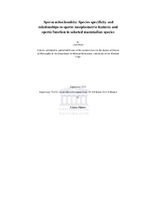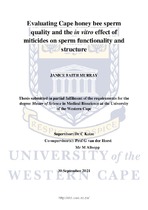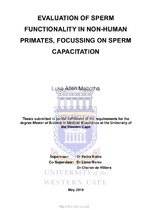| dc.contributor.advisor | van der Horst, Gerhard | |
| dc.contributor.advisor | Kotzé, Sanet | |
| dc.contributor.advisor | Henkel, Ralf | |
| dc.contributor.author | Maree, Liana | |
| dc.contributor.other | Dept. of Medical BioSciences | |
| dc.date.accessioned | 2014-03-28T08:05:19Z | |
| dc.date.available | 2013/03/20 | |
| dc.date.available | 2013/03/20 16:04 | |
| dc.date.available | 2014-03-28T08:05:19Z | |
| dc.date.issued | 2011 | |
| dc.identifier.uri | http://hdl.handle.net/11394/3053 | |
| dc.description | Philosophiae Doctor - PhD | en_US |
| dc.description.abstract | Numerous studies on mammalian spermatozoa have reported large variations in the dimensions of the main sperm structural components, namely the head, midpiece and flagellum. These variations in sperm architecture are believed to be adaptations for functioning of spermatozoa in complex environments outside the male reproductive system. The midpiece of the mammalian permatozoon contains a varied number of mitochondria, but the reason for the marked difference in the size and structure of this sperm component is not clear. This study confirmed the variations in the sperm morphometry of seven selected mammalian species and revealed unique features of the sperm midpiece and sperm mitochondria of these seven species. Evaluation of several sperm kinematic parameters revealed the unique swimming characteristics of the different spermatozoa. The importance of using standardized motility parameters was highlighted as well as the assessment of different subpopulations of spermatozoa in order to produce more reliable and comparable data. Investigating the role of sperm mitochondria in human sperm metabolism indicated that these organelles are related to sperm function in terms of sperm motility. Furthermore, it was suggested that glycolysis and mitochondrial respiration are linked processes and that both are important for the maintenance of human sperm motility. By optimizing and employing standardized experimental procedures and analysis techniques, this study was able to confirm the species specificity of almost all the sperm parameters evaluated, while also elucidating the phylogenetic relatedness of the non-human primate species. In conclusion, the present study has confirmed that the various midpiece morphometry parameters are related to the remaining sperm morphometry parameters as well as to the sperm kinematic parameters. These proposed associations between the various sperm parameters were used to explain the sperm velocity of two hypothetical and morphologically different sperm structures. Therefore, the results of the current study support the idea of co-evolution between sperm components in mammalian spermatozoa and propose that the midpiece morphometry parameters that are selected for in these spermatozoa are midpiece volume, total number of mitochondrial gyres, thickness of the mitochondrial sheath and mitochondrial height. | en_US |
| dc.language.iso | en | en_US |
| dc.publisher | University of the Western Cape | en_US |
| dc.subject | Sperm mitochondria | en_US |
| dc.subject | Sperm morphometry | en_US |
| dc.subject | Sperm midpiece | en_US |
| dc.subject | Sperm motility | en_US |
| dc.subject | Sperm kinematics | en_US |
| dc.subject | Sperm metabolism | en_US |
| dc.subject | Mammals | en_US |
| dc.subject | Computer-aided sperm/semen analysis | en_US |
| dc.subject | Glycolysis | en_US |
| dc.subject | Oxidative phosphorylation | en_US |
| dc.title | Sperm mitochondria: species specificity and relationships to sperm morphometric features and sperm function in selected mammalian species | en_US |
| dc.rights.holder | Copyright: University of the Western Cape | en_US |
| dc.description.country | South Africa | |




